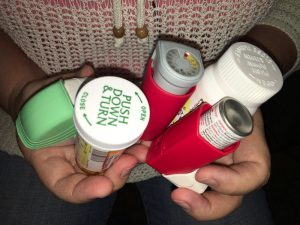- Slug: Valley Fever. 550 words.
- Video story available
- Photos available (thumbnails and captions below)
- Interactive map available (embed code below)
By NATALIE TARANGIOLI
Cronkite News
PHOENIX – Doctors are recommending new detection and treatment guidelines for Valley Fever, a deadly and debilitating infection that mimics the flu.
More than 4,000 cases have emerged so far this year, according to the Arizona Department of Health Services. People inhale fungus in soil, causing a fungal infection that can leave patients exhausted and with muscle aches, a fever, cough, headaches and night sweats. It can last for weeks, even months.
The illness is often misdiagnosed as a cold, flu or pneumonia, leaving people to suffer and leading to costly medical tests and hospitalizations.
Dr. John Galgiani, director of the Valley Fever Center for Excellence in Tucson, said early diagnosis is key to combating Valley Fever. Galgiani led a panel of 15 other medical experts, who developed new guidelines that make it much easier for doctors to pinpoint a patient’s symptoms with the corresponding illness.
For example, different procedures are recommended based on factors including the presence of an immunosuppressing condition like HIV, if the patient was recently diagnosed with Valley Fever or if the medication should be taken orally or intravenously.
There also are new protocols for treating pregnant women and people who have traveled to an area where Valley Fever is prevalent. Knowing someone’s travel history can make a difference in a proper diagnosis.
“If it were done better and earlier diagnoses were made, a lot of care would be considered unnecessary and you wouldn’t have to do it,” Galgiani said. “Many procedural imaging like CAT scans and things may not be necessary.”
Registered nurse Carla Gargiulo said she went through several urgent-care and hospital visits before a 2 1/2-centimeter nodule on her right lung confirmed she had Valley Fever.
“I kind of went back and thought, ‘Oh my gosh, maybe I should have pushed this a little further, maybe I should’ve been a little more aggressive with my own care,’” said Gargiulo, who was diagnosed in December 2014.
Her mild asthma became so severe after her illness she now relies on three inhalers a day and uses a small-volume nebulizer when she feels short of breath. She sleeps on a couch on the first floor of her Gilbert home because it’s difficult to make it up the stairs.
“Right now I’m in a vicious cycle,” Gargiulo said.
Galgiani said patients and their health-care professionals should seek Valley Fever tests if the patient experiences Valley Fever symptoms.
“These guidelines in many respects reinforced what we said before,” said Galgiani, whose center is based at the University of Arizona College of Medicine. “They specifically ask questions; if you have a patient with a certain set of symptoms, do you start an anti-fungal drug or not? And then there’s a basis for why that answer is our recommendation.”
Another change in the guidelines is certain drugs previously thought to be unsafe to use during pregnancy are now known to be safe, according to Galgiani.
He said a vaccine would protect those in high-risk areas like Arizona and the Central Valley of California, where the most cases of Valley Fever occur. He thinks one for dogs, who are three times more likely than humans to become infected, could be available in five years.
“The University of Arizona actually is working on a drug which might potentially cure this disease,” Galgiani said.
Embed code:
<div class=’tableauPlaceholder’ id=’viz1474571979822′ style=’position: relative’><noscript><a href=’#’><img alt=’Dashboard 1 ‘ src=’https://public.tableau.com/static/images/Va/ValleyFeverCases2016revised/Dashboard1/1_rss.png’ style=’border: none’ /></a></noscript><object class=’tableauViz’ style=’display:none;’><param name=’host_url’ value=’https%3A%2F%2Fpublic.tableau.com%2F’ /> <param name=’site_root’ value=” /><param name=’name’ value=’ValleyFeverCases2016revised/Dashboard1′ /><param name=’tabs’ value=’no’ /><param name=’toolbar’ value=’yes’ /><param name=’static_image’ value=’https://public.tableau.com/static/images/Va/ValleyFeverCases2016revised/Dashboard1/1.png’ /> <param name=’animate_transition’ value=’yes’ /><param name=’display_static_image’ value=’yes’ /><param name=’display_spinner’ value=’yes’ /><param name=’display_overlay’ value=’yes’ /><param name=’display_count’ value=’yes’ /></object></div> <script type=’text/javascript’> var divElement = document.getElementById(‘viz1474571979822’); var vizElement = divElement.getElementsByTagName(‘object’)[0]; if ( divElement.offsetWidth > 800 ) { vizElement.style.minWidth=’404px’;vizElement.style.maxWidth=’804px’;vizElement.style.width=’100%’;vizElement.style.minHeight=’319px’;vizElement.style.maxHeight=’569px’;vizElement.style.height=(divElement.offsetWidth*0.75)+’px’;} else if ( divElement.offsetWidth > 500 ) { vizElement.style.minWidth=’404px’;vizElement.style.maxWidth=’804px’;vizElement.style.width=’100%’;vizElement.style.minHeight=’319px’;vizElement.style.maxHeight=’569px’;vizElement.style.height=(divElement.offsetWidth*0.75)+’px’;} else { vizElement.style.width=’100%’;vizElement.style.height=(divElement.offsetWidth*0.75)+’px’;} var scriptElement = document.createElement(‘script’); scriptElement.src = ‘https://public.tableau.com/javascripts/api/viz_v1.js’; vizElement.parentNode.insertBefore(scriptElement, vizElement); </script>
^__=

